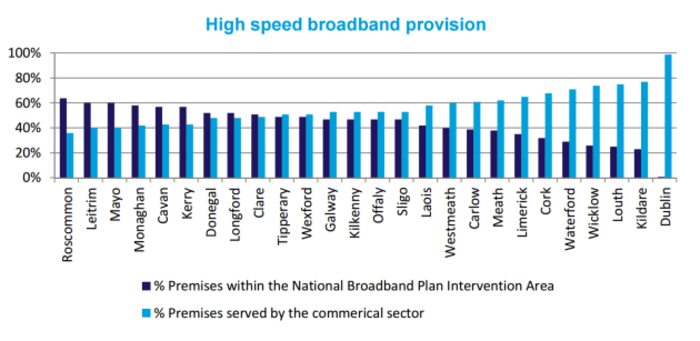This is the county with the worst broadband access in Ireland
Just over a third of the premises in Roscommon have access to high-speed internet.
ROSCOMMON IS THE county that the worst high-speed internet access in Ireland, according to a new study.
The finding is contained in a report produced by business group Ibec, which profiled a range of ‘economic indicators’ across all 31 local authority areas such as how much money is made from tourism.
For one of the key indicators, broadband connectivity, it examined the number of premises in a county that should have access high-speed broadband from commercial operators in 2016.
Using statistics from the Department of Communications, the Ibec report found that, nationally, 57% of premises were on course to be connected to high-speed broadband as of that year.
The remaining 43% of premises fell within the National Broadband Plan intervention area. The broadband plan is an initiative aimed at bringing government-subsidised high-speed internet to parts of the country that commercial operators won’t touch.
All premises in the country were due to have access to high-speed broadband by 2020 under the plan, however in April the government pushed out that completion date to 2022.
Western lag
The Ibec report said that Dublin, unsurprisingly, had the best connectivity out of the 26 counties. Some 99% of premises were on course to have access to high-speed broadband.
Roscommon was found to have the worst connectivity, with just 36% of premises having access to high-speed broadband.
Counties in the west of the country generally had worse broadband access than those in the east. The connectivity in Leitrim was 40%, while the figure was also 40% in Mayo.

“The requirement for state intervention rises as you move westwards across the country, with the western region having the most premises within the planned intervention area,” the Ibec report said.
“The digital economy plays an increasingly crucial role in the exchange of goods and services. Insufficient broadband connectivity leaves local businesses and householders at a significant disadvantage.”
It added: “Data intensive industries are increasingly mobile and have provided vital boosts in job creation around the country.
“Attracting these industries, that rely on reliable high quality connections, remains a challenge in some local authority areas.”
Broadband speeds
The areas with the worst connectivity also tend to have the slowest average broadband speeds.
Data from price comparison website and switching service Switcher.ie from November found that the worst town for broadband speeds is Legan in Longford, with an average download speed of 1.98Mbps.
While Longford came out the with the slowest average speed, Leitrim, Roscommon, and Mayo are all in the bottom five.
Ibec senior policy executive Aidan Sweeney said: “The findings in our report show that we must progress the National Planning Framework without delay to address the growing imbalance between Dublin and the rest of the country.”
The National Planning Framework, which the state is starting to draw up, is the government’s long-term plan for what Ireland should be like in about twenty years time.






